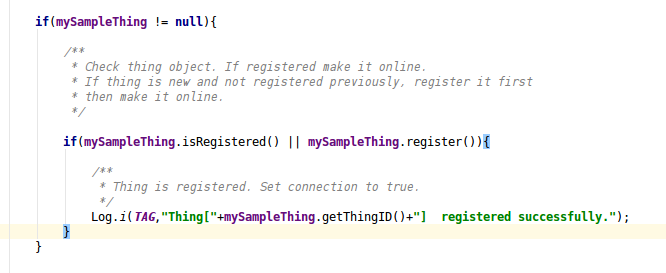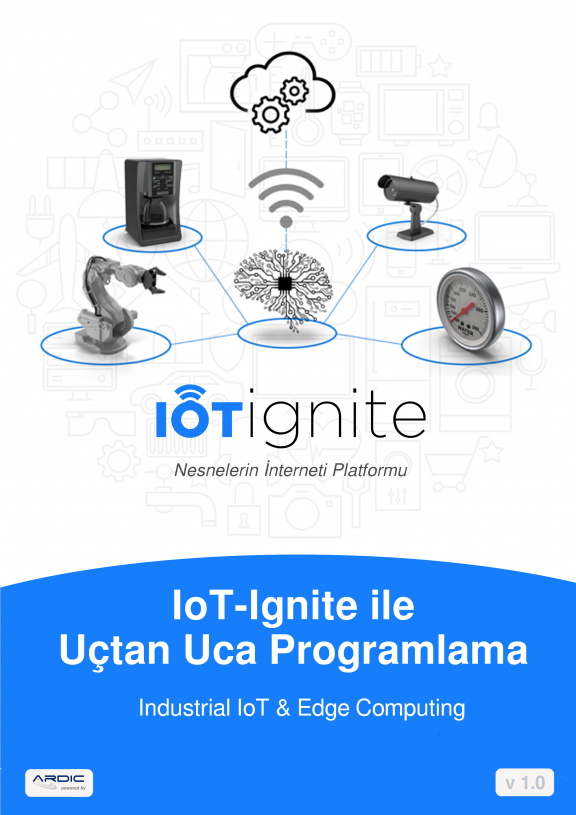Registering A Thing To IoT-Ignite
In this tutorial, you will learn how to register a thing to IoT-Ignite.
What is a Thing?
Thing objects are the endpoints of IoT-Ignite. In IoT-Ignite, every sensor and actuator is presented as a thing. You have to connect a thing to IoT-Ignite and register it to one node .
Every “thing” object can receive configuration and action messages. It can send several types of data to IoT-Ignite.
You can find detailed information about connecting your application to IoT-Ignite in Connecting Android Application to IoT-Ignite document.
You can also find detailed information about how to register a node in Registering Node to IoT-Ignite document.
Step 1: Create a Thing
First, define an instance:
private Thing mySampleThing;
Step 2: Create an Instance Using Node
Create the thing instance using previously created node.
mySampleThing = mySampleNode.createThing(
/* Thing ID must be unique */
THING_ID,
/**Define your thing type here. Use ThingType object.
* Thing Type objects give information about what type of sensor/actuator you are using. */
sampleThingType,
/** You can categorize your thing as EXTERNAL, BUILTIN or UNDEFINED. */
ThingCategory.EXTERNAL,
/**This boolean flag states if your thing can act as an actuator or not.
* When true,
* This thing can receive action messages over listener callback besides snding data.
* When false
* This thing will only generate data but will not receive action commands.*/
true,
/** Thing Listener : Callback for thing objects. Listener has three callbacks:
* - onConfigurationReceived(): Occurs when configuration setted by IoT-Ignite.
* - onActionReceived(): If your thing is set as an actuator, action messages sent will be handled here.
* - onThingUnregistered(): This is called when thing is unregistered from IoT-Ignite. */
this,
/** Reserved for later use. Pass null for now. */
null
);
Step 3: Registering Thing
You have created the thing object successfully. Now it is time to register it. You can register the thing object calling by:
mySampleThing.register();

Step 4: Setting the Thing’s Connection
You have successfully registered your thing. Now let’s set this thing as online.
mySampleThing.setConnected(true,"");

You can see the full code below:
public class IotIgniteHandler implements ConnectionCallback,NodeListener,ThingListener {
private static final String TAG = IotIgniteHandler.class.getSimpleName();
// Static singleton instance
private static IotIgniteHandler INSTANCE = null;
private static final long IGNITE_RECONNECT_INTERVAL = 10000L;
private static final String NODE_ID = "My Example Node";
private static final String THING_ID = "My Example Thing";
private IotIgniteManager mIotIgniteManager;
private boolean igniteConnected = false;
private Context appContext;
private Handler igniteWatchdog = new Handler();
private Node mySampleNode;
private Thing mySampleThing;
private ThingType sampleThingType = new ThingType(
/** Define Type of your Thing */
"My Sample Thing Type",
/** Set your things vendor. It's useful if you are using real sensors
* This is important for separating identical sensors manufactured by different vendors.
* For example accelerometer sensor produced by Bosch data sampling is
* different than Samsung's.*/
"My Sample Vendor",
/** Set thing data type.
*/
ThingDataType.INTEGER
);
private Runnable igniteWatchdogRunnable = new Runnable() {
@Override
public void run() {
if(!igniteConnected){
rebuildIgnite();
igniteWatchdog.postDelayed(this,IGNITE_RECONNECT_INTERVAL);
Log.e(TAG,"Ignite is not connected. Trying to reconnect...");
}else {
Log.e(TAG,"Ignite is already connected.");
}
}
};
private IotIgniteHandler(Context context){
this.appContext = context;
}
public static synchronized IotIgniteHandler getInstance(Context appContext){
if(INSTANCE == null){
INSTANCE = new IotIgniteHandler(appContext);
}
return INSTANCE;
}
public void start(){
startIgniteWatchdog();
}
@Override
public void onConnected() {
Log.i(TAG,"Ignite Connected");
// cancel watchdog //
igniteWatchdog.removeCallbacks(igniteWatchdogRunnable);
igniteConnected = true;
Log.i(TAG,"Creating Node: " + NODE_ID);
mySampleNode = IotIgniteManager.NodeFactory.createNode(
/*Unique ID of Node*/
NODE_ID,
/* Node label may be unique. */
NODE_ID,
/*Node Type is definition for node. If your node is a physical device, you can state it here.
* Supported Node Types
* GENERIC : Default node type. If you do not want to do type based things, this will work for you.
* RASPBERRY_PI: Defines node as a Raspberry Pi.
* If your node is Raspberry Pi and you are going to deal with "RasPi" specific things like RaspiCam, choose this one.
* ARDUINO_YUN: Defines node as Arduino Yun. Use it for Arduino Yun specific things like Bridge etc. */
NodeType.GENERIC,
/** Reserved for later use. Pass null for now.*/
null,
/*Node Listener : Callback for node unregistration. Nodes can be unregistered from enterprise.iot-ignite.com remotely.
* If your node is unregistered from there but not by your code, will receive a callback here. */
this
);
/**
* Check node object and register it.
*/
if(mySampleNode != null ) {
/**
* Node is not null and not registered. Register first and set connection online.
* If you don't set connection true you can not send data over it.
*
*/
Log.i(TAG, mySampleNode.getNodeID() + " created.");
if (!mySampleNode.isRegistered()) {
Log.i(TAG, mySampleNode.getNodeID() + " is registering...");
/**
* Register node here. If registration is successful, make it online.
*/
if (mySampleNode.register()) {
Log.i(TAG, mySampleNode.getNodeID() + " is registered successfully. Setting connection true");
mySampleNode.setConnected(true, "");
}
} else {
/**
* Node is already registered. Set connection to true.
*/
Log.i(TAG, mySampleNode.getNodeID() + " has already registered. Setting connection true");
mySampleNode.setConnected(true, "");
}
}
/**
* As node is registered, it is time to bound a thing to our node.
*/
if(mySampleNode != null && mySampleNode.isRegistered()){
mySampleThing = mySampleNode.createThing(
/*Thing ID : Must be unique*/
THING_ID,
/*Define your thing type here. Use ThingType object.
* Thing Type objects give information about what type of sensor/actuator you are using.*/
sampleThingType,
/** You can categorize your thing. EXTERNAL, BUILTIN or UNDEFINED */
ThingCategory.EXTERNAL,
/**If your thing going to to same action for example opening something or triggering relay,
* Set this true. When set it true your things can receive action messages over listener callback.
* Otwervise if your thing is only generating data. Set this false.*/
true,
/** Thing Listener : Callback for thing objects. Listener has three callbacks:
* - onConfigurationReceived() : Occurs when configuration setted by IoT-Ignite.
* - onActionReceived(): If your thing set as actuator action message will handle here.
* - onThingUnregistered(): If your thing unregister from IoT-Ignite you will receive this callback.*/
this,
/** Reserved for later uses. Pass null for now. */
null
);
}
if(mySampleThing != null){
/**
* Check thing object. If registered make it online.
* If thing is new and not registered previously, register it first
* then make it online.
*/
if(mySampleThing.isRegistered() || mySampleThing.register()){
/**
* Thing is registered. Set connection to true.
*/
Log.i(TAG,"Thing["+mySampleThing.getThingID()+"] is registered.");
mySampleThing.setConnected(true,"");
}
}
}
@Override
public void onDisconnected() {
Log.i(TAG,"Ignite Disconnected");
// start watchdog again here.
igniteConnected = false;
startIgniteWatchdog();
}
/**
* Connect to iot ignite
*/
private void rebuildIgnite(){
try {
mIotIgniteManager = new IotIgniteManager.Builder()
.setConnectionListener(this)
.setContext(appContext)
.build();
} catch (UnsupportedVersionException e) {
Log.e(TAG, "UnsupportedVersionException :" + e);
}
}
/**
* remove previous callback and setup new watchdog
*/
private void startIgniteWatchdog(){
igniteWatchdog.removeCallbacks(igniteWatchdogRunnable);
igniteWatchdog.postDelayed(igniteWatchdogRunnable,IGNITE_RECONNECT_INTERVAL);
}
@Override
public void onNodeUnregistered(String s) {
}
/**
* Set all things and nodes connection to offline.
* When the application close or destroyed.
*/
public void shutdown(){
if(mySampleNode!=null){
if(mySampleThing != null){
mySampleThing.setConnected(false,"Application Destroyed");
}
mySampleNode.setConnected(false,"Application Destroyed");
}
}
@Override
public void onConfigurationReceived(Thing thing) {
/**
* Thing configuration messages will be handled here.
* For example data sending frequency or custom configuration may be in the incoming thing object.
*/
}
@Override
public void onActionReceived(String s, String s1, ThingActionData thingActionData) {
/**
* Thing action message will be handled here. Call thingActionData.getMessage()
*/
}
@Override
public void onThingUnregistered(String s, String s1) {
/**
* If your thing object is unregistered from outside world, you will receive this
* information callback.
*/
}
}
Step 5: Test
Build and run your application. Your device inventory will be sent to the IoT-Ignite Cloud and you will be able to see it.
Go to IoT-Ignite Enterprise and log in with your account credential. Then, you should go to details of your gateway in the gateways page. In the gateway details page, when you click on sensors tab you can see:

Happy Codings,






